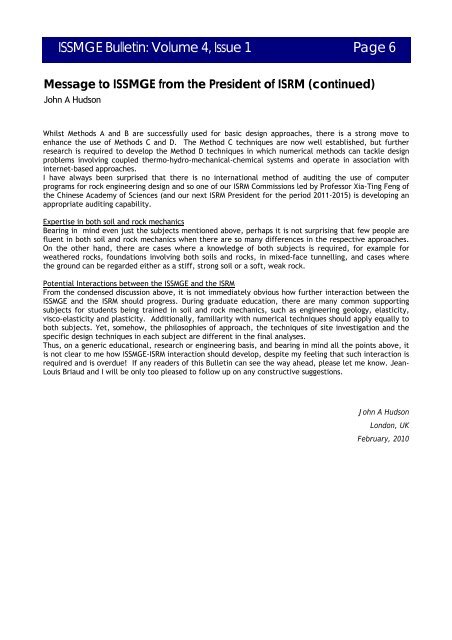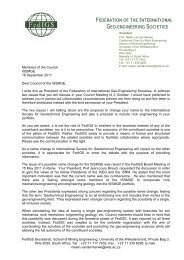Vol. 4, Issue 1, March 2010 - Australian Geomechanics Society
Vol. 4, Issue 1, March 2010 - Australian Geomechanics Society
Vol. 4, Issue 1, March 2010 - Australian Geomechanics Society
Create successful ePaper yourself
Turn your PDF publications into a flip-book with our unique Google optimized e-Paper software.
ISSMGE Bulletin: <strong>Vol</strong>ume 4, <strong>Issue</strong> 1 Page 6<br />
Message to ISSMGE from the President of ISRM (continued)<br />
John A Hudson<br />
Whilst Methods A and B are successfully used for basic design approaches, there is a strong move to<br />
enhance the use of Methods C and D. The Method C techniques are now well established, but further<br />
research is required to develop the Method D techniques in which numerical methods can tackle design<br />
problems involving coupled thermo-hydro-mechanical-chemical systems and operate in association with<br />
internet-based approaches.<br />
I have always been surprised that there is no international method of auditing the use of computer<br />
programs for rock engineering design and so one of our ISRM Commissions led by Professor Xia-Ting Feng of<br />
the Chinese Academy of Sciences (and our next ISRM President for the period 2011-2015) is developing an<br />
appropriate auditing capability.<br />
Expertise in both soil and rock mechanics<br />
Bearing in mind even just the subjects mentioned above, perhaps it is not surprising that few people are<br />
fluent in both soil and rock mechanics when there are so many differences in the respective approaches.<br />
On the other hand, there are cases where a knowledge of both subjects is required, for example for<br />
weathered rocks, foundations involving both soils and rocks, in mixed-face tunnelling, and cases where<br />
the ground can be regarded either as a stiff, strong soil or a soft, weak rock.<br />
Potential Interactions between the ISSMGE and the ISRM<br />
From the condensed discussion above, it is not immediately obvious how further interaction between the<br />
ISSMGE and the ISRM should progress. During graduate education, there are many common supporting<br />
subjects for students being trained in soil and rock mechanics, such as engineering geology, elasticity,<br />
visco-elasticity and plasticity. Additionally, familiarity with numerical techniques should apply equally to<br />
both subjects. Yet, somehow, the philosophies of approach, the techniques of site investigation and the<br />
specific design techniques in each subject are different in the final analyses.<br />
Thus, on a generic educational, research or engineering basis, and bearing in mind all the points above, it<br />
is not clear to me how ISSMGE-ISRM interaction should develop, despite my feeling that such interaction is<br />
required and is overdue! If any readers of this Bulletin can see the way ahead, please let me know. Jean-<br />
Louis Briaud and I will be only too pleased to follow up on any constructive suggestions.<br />
John A Hudson<br />
London, UK<br />
February, <strong>2010</strong>




